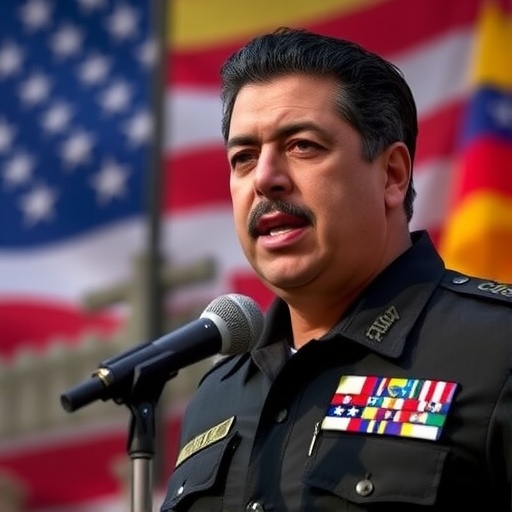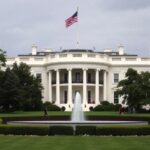Venezuela‘s Maduro Accuses U.S. of Fabricating War as American Warship Nears Shores
In a blistering address that has sent shockwaves through international diplomacy, Venezuela‘s President Nicolás Maduro has boldly accused the United States of fabricating a war pretext to justify military intervention. The explosive claim came as a formidable U.S. Navy warship, the USS Gerald R. Ford, was reported steaming toward Venezuelan waters in the Caribbean Sea, heightening fears of an imminent confrontation. This development unfolds against a backdrop of longstanding tensions between Venezuela and the U.S., where economic sanctions and political disputes have long simmered, now threatening to boil over into open conflict.
- Maduro’s Accusation Echoes Chávez-Era Defiance Against U.S. ‘Imperialism’
- U.S. Warship Deployment Fuels Speculation of Covert Operations in Caribbean Waters
- Escalating Border Tensions with Guyana Amplify Fears of Broader U.S. Involvement
- Global Powers React as Venezuela-U.S. Standoff Risks Wider Conflict
- Pathways to De-escalation: Diplomacy or Brinkmanship in U.S.-Venezuela Ties?
Maduro’s rhetoric, delivered during a nationally televised speech from Caracas on Tuesday evening, painted the U.S. as an imperial aggressor orchestrating a false flag operation. “They are fabricating a war to invade our sovereign land,” Maduro thundered, his voice echoing the defiance that has defined his leadership since succeeding Hugo Chávez in 2013. The accusation arrives at a precarious moment, with the warship’s approach coinciding with joint military exercises involving Venezuelan forces along the border with Guyana, a dispute over oil-rich territory that has drawn U.S. scrutiny.
Experts warn that this escalation could destabilize the entire South American region, reminiscent of Cold War-era standoffs. With Venezuela’s economy already crippled by U.S. sanctions—imposed since 2017 and totaling over $130 billion in lost revenue, according to Venezuelan government estimates—the specter of war looms large. As the USS Gerald R. Ford, capable of carrying 75 aircraft and over 4,500 personnel, closes in, the world watches with bated breath, wondering if words will turn to weapons.
Maduro’s Accusation Echoes Chávez-Era Defiance Against U.S. ‘Imperialism’
President Maduro’s latest salvo against the U.S. is not without precedent; it revives the fiery anti-imperialist rhetoric that propelled his mentor, Hugo Chávez, to power. In his speech, Maduro specifically alleged that Washington is “manufacturing threats” to mask its intent to seize Venezuela’s vast oil reserves, the largest proven in the world at over 300 billion barrels. “This is not about democracy; it’s about domination,” he declared, pointing to recent U.S. statements criticizing Venezuela’s handling of the Essequibo region dispute with Guyana.
The context is rich with historical friction. Since the early 2000s, Venezuela has viewed U.S. foreign policy as a direct threat, from the 2002 coup attempt against Chávez—widely believed to have U.S. backing—to the recognition of opposition leader Juan Guaidó as interim president in 2019. Maduro’s government claims these moves are part of a broader strategy to topple the Bolivarian Revolution. In 2023 alone, U.S. sanctions targeted over 100 Venezuelan entities, including PDVSA, the state oil company, exacerbating hyperinflation that peaked at 1.7 million percent in 2018.
Quoting from the speech, Maduro warned, “The Yankee empire thinks it can bully us into submission, but our people are ready to defend every inch of our territory.” This narrative resonates deeply in Venezuela, where state media has amplified the story, portraying the approaching warship as irrefutable proof of U.S. aggression. Analysts note that Maduro’s timing is strategic, rallying domestic support amid economic woes and upcoming elections in 2024.
Furthermore, Venezuelan officials have mobilized National Guard units along coastal areas, conducting drills that simulate repelling naval incursions. Satellite imagery from independent monitors shows increased activity at key ports like La Guaira, underscoring the gravity of Maduro’s claims. As tensions mount, the accusation of a fabricated war has become a rallying cry, blending nationalism with paranoia over U.S. intentions.
U.S. Warship Deployment Fuels Speculation of Covert Operations in Caribbean Waters
The USS Gerald R. Ford’s deployment has ignited a firestorm of speculation, with military experts dissecting its implications for U.S.-Venezuela relations. Launched in 2017 at a cost of $13 billion, this nuclear-powered supercarrier represents the pinnacle of American naval might, equipped with advanced radar systems and F-35 stealth fighters. Its route, tracked by the U.S. Naval Institute, brings it within 200 nautical miles of Venezuela’s exclusive economic zone, a proximity that Caracas deems provocative.
U.S. officials have downplayed the move, stating it’s part of routine freedom-of-navigation operations in international waters. “Our presence in the Caribbean is to ensure stability and counter illicit activities, not to threaten neighbors,” said Pentagon spokesperson John Kirby in a briefing Wednesday. However, the timing—mere days after Maduro’s re-election amid fraud allegations—raises eyebrows. The warship’s escort includes destroyers and submarines, forming what analysts call a “carrier strike group,” capable of projecting power across the hemisphere.
In Venezuela, the sight of this behemoth has stirred public anxiety. Social media is ablaze with images of the carrier, shared by locals fearing an invasion akin to the 1989 U.S. intervention in Panama. Government reports claim U.S. drones have been spotted over Venezuelan airspace, though unverified. Economically, the warship’s approach has already impacted oil markets; Brent crude futures rose 2.5% overnight, reflecting investor jitters over potential disruptions to Venezuela’s 700,000 barrels-per-day exports.
Regional security experts, like those from the Council on Foreign Relations, argue this deployment is a show of force to deter Venezuela’s alliances with Russia and Iran. Moscow has supplied Caracas with S-300 air defense systems, while Tehran aids in oil refining. A U.S. State Department cable leaked to media outlets hints at concerns over Venezuelan ports being used for arms smuggling, adding layers to the war fabrication narrative.
- Key Specs of USS Gerald R. Ford: 1,106 feet long, 100,000 tons displacement, crew of 4,500.
- Strategic Range: Can operate 1,000 miles inland with its air wing.
- Historical Precedent: Similar deployments preceded the 2019 Venezuela aid crisis.
As the vessel nears, Venezuelan radar stations are on high alert, monitoring for any deviation into territorial waters, which could trigger a diplomatic incident or worse.
Escalating Border Tensions with Guyana Amplify Fears of Broader U.S. Involvement
Beneath the surface of Maduro’s U.S. war accusations lies a simmering territorial dispute with Guyana over the Essequibo region, a 160,000-square-kilometer area rich in offshore oil discoveries. ExxonMobil’s finds there—estimated at 11 billion barrels—have turned the once-obscure border into a geopolitical hotspot, drawing U.S. interest as a counterweight to Venezuelan influence.
Venezuela claims historical rights dating to the 19th century, rejecting a 1899 arbitration award as fraudulent. In December 2023, a referendum saw 95% of Venezuelans vote to annex Essequibo, prompting Maduro to order military incursions. Guyana, backed by the U.S. and UK, has fortified its defenses, with American advisors training Guyanese troops. The warship’s approach is seen by some as a signal to Caracas: don’t escalate.
“This is about resources, not rhetoric,” opined Dr. María López, a Latin American studies professor at Georgetown University. “The U.S. views Venezuela’s moves as destabilizing, especially with China and Russia circling.” Indeed, Beijing has invested $60 billion in Venezuelan infrastructure, while Russian Wagner mercenaries were rumored to operate in Essequibo until their 2023 mutiny.
Statistics paint a dire picture: Guyana’s economy has boomed 60% since 2015 oil finds, contrasting Venezuela’s 75% GDP contraction over the same period. U.S. sanctions, renewed in October 2023 after Maduro expelled American diplomats, have isolated Caracas further. In response, Venezuela has strengthened ties with BRICS nations, seeking alternatives to the dollar-dominated oil trade.
- Timeline of Essequibo Dispute: 1899 arbitration; 1966 independence of Guyana; 2015 Exxon discovery; 2023 referendum.
- U.S. Role: Provided $10 million in military aid to Guyana in 2024.
- Potential Flashpoints: Venezuelan navy patrols near St. Vincent Island, close to Guyanese waters.
The convergence of the warship and border rhetoric suggests Maduro’s fabrication claim is a preemptive strike, framing any U.S. action as aggression rather than defense of allies.
Global Powers React as Venezuela-U.S. Standoff Risks Wider Conflict
The international community is scrambling to respond to the Venezuela-U.S. war of words, with reactions ranging from condemnation to cautious diplomacy. The United Nations Security Council scheduled an emergency session Thursday, where Russia’s ambassador accused the U.S. of “gunboat diplomacy,” echoing Maduro’s narrative. China, Venezuela’s largest creditor with $10 billion in loans, urged restraint, while quietly boosting oil purchases from Caracas.
In Latin America, Brazil’s President Lula da Silva called for dialogue, offering Brasília as a neutral venue. “War benefits no one in our region,” Lula stated, referencing his own past clashes with U.S. policy. Colombia, sharing a 1,400-mile border with Venezuela, has sealed crossings amid refugee fears, with over 2.5 million Venezuelans already displaced regionally since 2014.
European Union foreign ministers issued a joint statement supporting Guyana’s sovereignty and calling on Venezuela to abide by International Court of Justice rulings. Meanwhile, Iran and Cuba—longtime Venezuelan allies—have dispatched diplomatic envoys, with Havana denouncing U.S. sanctions as “economic warfare.” Quotes from Iranian President Ebrahim Raisi highlight solidarity: “We stand with Venezuela against imperialist fabrication.”
Economic ripples are felt globally; the International Monetary Fund projects a 0.5% drag on Latin American growth if tensions persist. Oil prices, volatile at $85 per barrel, could spike to $100 if Venezuelan exports halt, impacting U.S. consumers amid inflation concerns. Humanitarian groups like Amnesty International warn of a crisis, with Venezuela’s 7 million internal migrants at risk.
As voices multiply, the standoff underscores a multipolar world where U.S. hegemony faces challenges, potentially redrawing alliances in the Western Hemisphere.
Pathways to De-escalation: Diplomacy or Brinkmanship in U.S.-Venezuela Ties?
Looking ahead, the Venezuela-U.S. impasse teeters between diplomatic breakthroughs and perilous brinkmanship. Backchannel talks, mediated by Norway since 2022, have yielded partial sanction relief in exchange for electoral guarantees, but Maduro’s war fabrication accusation has eroded trust. Upcoming Organization of American States meetings in Washington could serve as a forum, though Venezuela’s 2020 withdrawal complicates matters.
Military analysts predict the USS Gerald R. Ford will linger for exercises with allies like Trinidad and Tobago, signaling resolve without direct provocation. Venezuela, in turn, may leverage OPEC+ production cuts—agreed in June 2023—to pressure markets. Long-term, resolving the Essequibo dispute via arbitration could ease tensions, but Maduro’s domestic politics demand a hardline stance.
Implications extend to global energy security; a war scenario could displace 500,000 barrels daily, rivaling the 2022 Ukraine crisis impacts. U.S. policymakers face a dilemma: tighten sanctions, risking refugee surges at the border, or engage pragmatically for oil stability. As Maduro vows “peaceful resistance,” the international community pushes for talks, hoping rhetoric yields to reason before the warship’s shadow engulfs the Caribbean.
In the coming weeks, expect intensified surveillance, potential UN resolutions, and perhaps a surprise summit. The stakes are existential for Venezuela’s sovereignty and U.S. credibility in Latin America, with the specter of fabricated war hanging like a storm cloud over the hemisphere.










